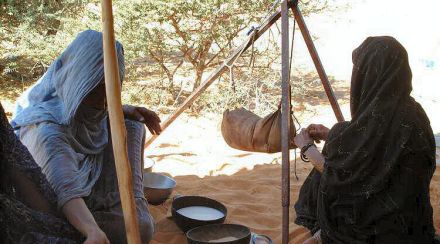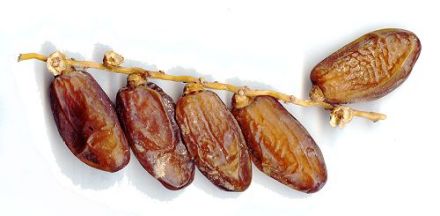 |
A Culinary Journey through Mauritania
Despite the rigors of the climate, raising livestock remains Mauritanians' main economic activity: they are mostly breeders of dromedaries, for whom the search for pasture land is tied to rain distribution.
The dromedary is still the essential ally of the nomads who crisscross the Sahara, even though the caravans are becoming increasingly fewer. This "ship" of the desert, besides transporting its owner's merchandise and personal effects, also provides indispensable calories through its flavorful meat and milk (zrig).
Tea
Among the nomads, tea is a true ritual of welcome, relaxation and negotiation. It is attributed with numerous properties, including alleviating hunger, thirst and fatigue. Preparing tea perfectly suits the nomadic lifestyle. The tea is green China tea "8147" and one does not drink one, but three, glasses of it. For this slow ceremony to take place, there are three conditions, the famous 3 Js: Jmari (the charcoal embers on which the teapot is placed); Jar (slowness - in infusing the leaves, serving and drinking); and Jmaa (the assembled people, since tea is rarely prepared just for one person). The first glass is strong, just the infused leaves. A glass is filled, then poured and repoured into the other glasses. There is an art to pouring the tea from a great height, creating a cascade of liquid sometimes a meter in length to reduce the bitterness and produce foam. Then the water in the pot is returned to the heat with the addition of mint and sugar, and the third time follows the same process, so that the theine content is increasingly reduced. Mauritanians say that the first glass is bitter like life, the second strong like love and the third suave like death. It is drunk to the very last drop, the "honey tear."

Arab Bedouins introduced dates, milk and bread, which are still the basic foods. The Moors brought elements of Andalusian cooking (olives, olive oil, hazelnuts, almonds, fruits and aromatic herbs), while the Arabs enriched the cuisine with spices. Cooking was traditionally the domain of women who, through their fertile imaginations, invented numerous dishes and variations of traditional recipes. Here are some of them, by region:
The north of the country
Meet the Imraguins on the arid northwest coast of Mauritania. These fishermen survive with the help of dolphins who drive the fish into their nets. Imraguins are the only people allowed to fish in the Arguin Bank National Park. One of their dishes - botarga, made from smoked mullet eggs - is a rare delicacy sought after by European gourmets.
Adrar (notheast) is proud of its famous flat cakes in sauce called "leksour."
Al-keçra
wheat or barley flatbread baked in the oven or in sand heated with coals. Now more often baked in a pot.
Guebla (southwest)
Al-'aich
thick millet, barley or wheat porridge
Abragat
millet flour and watermelon porridge
Cherchem
cooked unground millet
Mbellakh
the millet flour remaining after sifting (igjân) which is cooked in meat broth
National dishes
Kuskus
the basic food in many parts of the country. Made with millet, wheat or barley flour.
Maru we-llham
rice and meat seasoned with butter or butter oil
Al mechwi
meat cooked in the sand (hofra, foyer)
In the valley (south and southeast)
The cuisine is varied, influenced by Arab countries, Senegal, Mali and even the Touareg people.
Lathiri
fine couscous made from sorghum or millet flour, or even rice, topped with tomato sauce and served with meat, fish or herbs (hakou) and vegetables, or on its own with fresh milk or yogurt.
Thieboudiene
rice and fish cooked with carrots, eggplant, pumpkin, turnip, okra, tamarind, spices and chilies, depending on what is available. This dish is found in many African countries (see the recipe from Senegal).
Maru
rice in all its forms: with dried fish (guedi), smoked fish or meat, which may or may not be served with white beans or vegetables.
Benafé
stew in all its forms (with potatoes, pickled onions, etc.)
Firire
small or medium fish fried in oil and served with an often spicy tomato sauce
Carow or fondé
a light porridge made with large grains of millet or sorghum couscous, served with milk
Lakh
a thick paste (the same mixture as carow, but thicker) often eaten with the fingers (whereas carow, more liquid, is drunk).
all sorts of grilled products: meat, fish, poultry, etc.
A special mention of the town of Oualata (southeast), which has culinary specialties unique in the country, such as pigeon stuffed with dates, or the spices known as "chroutte" that are sprinkled on dishes just before serving.

Dates are an integral part of Mauritanian culture. Rich in sugar and an excellent source of calories and minerals, they are always served at the end of a meal or as a snack to ward off hunger - 1 kg of dates represents a ration of approximately 2,000 calories. The date harvest, or guetna, is an occasion for celebrations from July to September, as well as for the migration of the population to the oasis. One significant point: Mauritania consumes all its dates and does not export any.
Keep in mind that Mauritania is an Islamic republic: drinking alcohol is strictly forbidden for nationals. Some leeway is granted to foreigners, which allows you to have a beer or whisky in certain restaurants (from the owner's private stock which will not appear on the menu). You can always quench your thirst with the famous tea or share in the nomads' bowl of goat's or camel's milk combined with fresh well water.
Bon appétit from the land of sands!
Tea photo: Mahfoudh ould Kabach, guide in Mauritania. Other photos: Gilles Chertier, http://www.adrar.net

-

 Recipes
Recipes
-

 Products
Products
-

 Entertaining
Entertaining
-

 Chefs
Chefs
-

 Hints & Tips
Hints & Tips
-

 Glossaries
Glossaries








